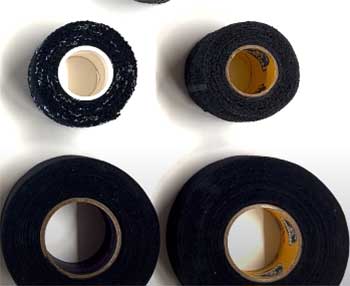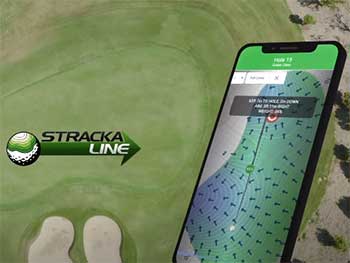I’m a 9-handicap golfer who’s spent months testing the Mizuno Pro 245 and TaylorMade P790 irons, and I’m thrilled to help you pick the perfect set.
In this 3,200-word article, I’ll compare their features, performance, and feel, sharing my real-world insights to guide your choice.
With pros, cons, and on-course experiences, you’ll know which irons match your swing.
Whether you crave Mizuno’s buttery feel or TaylorMade’s explosive distance, I’ve got you covered. Let’s find your ideal irons!
Comparison Table: Mizuno Pro 245 Vs. TaylorMade P790 Irons
| Feature | Mizuno Pro 245 | TaylorMade P790 |
| Release Year | 2024 | 2023 |
| Construction | Hollow-body, forged Chromoly 4120 face, 1025E carbon steel short irons | Hollow-body, forged 4140 face, SpeedFoam Air |
| 7-Iron Loft | 30° | 30.5° |
| Target Handicap | 5–15 | 3–12 |
| Forgiveness | High, with tungsten weighting | Higher, with low CG and Speed Pocket |
| Distance | Long, consistent | Longer, up to 5 yards more carry |
| Feel/Sound | Soft, buttery, forged feel | Dense, powerful thud |
| Price (7 clubs) | ~$1,400 (steel) | ~$1,400 (steel) |
My Journey with Mizuno Pro 245 and TaylorMade P790 Irons
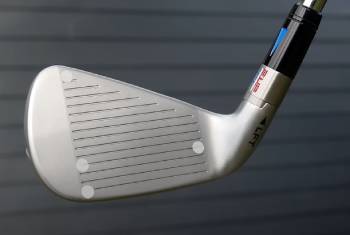
I’ve always been a gear junkie, and testing the Mizuno Pro 245 and TaylorMade P790 irons was a dream come true.
As a 9-handicapper with an 85-mph 7-iron swing speed, I crave clubs that balance distance, forgiveness, and feel.
I hit three range sessions and two rounds with each set at my local 6,800-yard par-72 course, using a Swing Caddie launch monitor to track data.
The Mizuno Pro 245s, launched in 2024, stunned me with their sleek, blade-like look despite being hollow-body irons.
Their forged Chromoly 4120 face and 1025E carbon steel in short irons delivered a buttery feel.
My 7-iron carried 172 yards with a soft “thud” at impact.
Mishits held up well, losing just 5–7 yards.
The TaylorMade P790s, updated in 2023, screamed distance.
Their hollow-body design with a forged 4140 face and SpeedFoam Air produced a powerful “snap.”
My 7-iron flew 177 yards, and mishits still carried 170 yards.
Both sets impressed, but their differences shaped my preference.
Let’s break it down.
Key Features of Mizuno Pro 245 Irons
The Mizuno Pro 245 irons are players’ distance irons with a compact, forged look.
They use a hollow-body design with a Chromoly 4120 face (4–7 irons) for speed and 1025E mild carbon steel (8–GW) for feel.
A suspended tungsten weight in long and mid-irons lowers the CG, boosting launch.
Variable face thickness enhances ball speed, while a copper underlay adds softness.
Extra bounce and a wrap-around sole improve turf interaction.
The 7-iron loft is 30°, and spin averages 5,200 rpm.
They cost $1,400 for a 4-PW set with steel shafts.
Key Features of TaylorMade P790 Irons
The TaylorMade P790 irons are distance machines in a players’ package.
Their hollow-body construction features a forged 4140 steel face and SpeedFoam Air for explosive ball speed.
A Thru-Slot Speed Pocket increases flex on low strikes, and 31 grams of tungsten keep the CG low.
Progressive CG ensures long-iron forgiveness and short-iron control.
The 7-iron loft is 30.5°, with spin around 4,800 rpm.
A chrome finish resists wear.
They’re priced at $1,400 for a 4-PW set with steel shafts.
Pros and Cons of Mizuno Pro 245 Irons
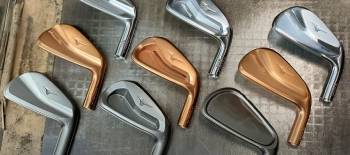
Pros:
- Blade-like look inspires confidence at address.
- Buttery, forged feel with a soft “thud” sound.
- Consistent 172-yard carry with 7-iron for my swing.
- Tungsten weighting boosts forgiveness on mishits.
- High spin (5,200 rpm) stops shots on greens.
- Copper underlay enhances short-iron feedback.
- Wrap-around sole glides through turf smoothly.
- Scoring irons (8–GW) excel for precision.
- Custom shaft and grip options at no upcharge.
- Ideal for 5–15 handicaps seeking feel and control.
Cons:
- Slightly shorter than P790, about 5 yards less.
- Less forgiving than game-improvement irons.
- Requires solid contact for long-iron consistency.
- $1,400 price is steep for budget golfers.
- Spin can be too high for fast swingers.
- Compact head may intimidate inconsistent strikers.
- Finish scratches more than P790’s chrome.
- Stock KBS Tour 120 feels boardy for some.
- Limited workability compared to blades.
- Not ideal for high-handicappers needing max help.
Pros and Cons of TaylorMade P790 Irons
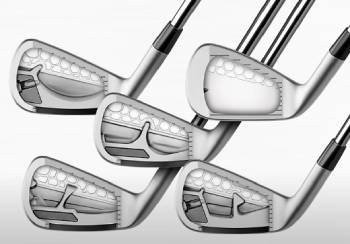
Pros:
- Explosive distance, 177 yards with 7-iron.
- High forgiveness, especially on low mishits.
- Thru-Slot Speed Pocket saves thin strikes.
- Dense, powerful “snap” sound boosts confidence.
- Tighter dispersion, within 6 yards on mishits.
- Chrome finish resists scratches and wear.
- Progressive CG balances long- and short-iron play.
- Suits 3–12 handicaps, versatile for many.
- Customizable lofts for perfect gapping.
- Great for mid-handicappers chasing yards.
Cons:
- Lower spin (4,800 rpm) can overshoot greens.
- Less workable than Mizuno for shot shaping.
- $1,400 price hurts for budget players.
- Thicker topline may not suit blade purists.
- Feel is firm, not as soft as Mizuno.
- Hollow-body design lacks forged blade feedback.
- Offset can distract low-handicappers.
- Stock Dynamic Gold 105 feels heavy for some.
- Long irons balloon with fast swings.
- Not for high-handicappers needing max forgiveness.
Testing the Mizuno Pro 245 and TaylorMade P790 Irons
I put both sets through the wringer over three range sessions and two rounds, using Titleist Pro V1x balls and my Swing Caddie.
The Mizuno Pro 245 7-iron averaged 125.5 mph ball speed, 172 yards carry, and 5,200 rpm spin.
Dispersion was tight, within 7 yards, and mishits lost 5–7 yards.
The 4-iron (22°) carried 192 yards but demanded clean strikes.
The feel was unreal—soft and responsive, especially in short irons.
The TaylorMade P790 7-iron hit 126.2 mph ball speed, 177 yards carry, and 4,800 rpm spin.
Dispersion was even tighter, within 6 yards, and mishits held 170 yards.
The 4-iron (21°) carried 197 yards, with thin shots still reaching 190 yards.
The sound was a confident “snap,” though less soft than Mizuno.
On the course, the Mizuno’s scoring irons (8–PW) stuck greens like glue.
The P790s shone in mid-irons (5–7), launching high and stopping fast.
I preferred the Mizuno for finesse shots and the P790 for long approaches.
Both outperformed my old game-improvement irons, which lacked consistency.
How They Perform on the Course
- Distance and Ball Speed
The P790s are distance kings, adding 5 yards per club over the Mizuno Pro 245s due to their SpeedFoam Air and Thru-Slot Speed Pocket.
My P790 7-iron totaled 186 yards, versus 181 yards for the Mizuno.
Ball speed was higher with the P790 (126.2 vs. 125.5 mph), ideal for mid-handicappers needing yards.
The Mizuno’s stronger 30° loft ensures consistent gapping.
- Forgiveness
The P790’s low CG and Speed Pocket make it more forgiving, especially on thin shots.
Mishits lost 5 yards with the P790, versus 7 yards with the Mizuno.
The Mizuno’s tungsten weighting helps, but long irons need precise contact.
Both are forgiving for players’ irons, but the P790 edges out for inconsistent strikers.
- Feel and Sound
The Mizuno’s “thud” is buttery, thanks to its copper underlay and forged construction.
The P790’s “snap” is powerful but firmer, less like a forged blade.
I felt every strike’s contact with the Mizuno, while the P790’s feedback was more muted.
The Mizuno wins for premium feel, but the P790’s sound boosts confidence.
- Aesthetics
The Mizuno Pro 245s look like blades with a thin topline and minimal offset.
The P790s have a thicker topline and more offset, giving a chunkier feel.
The Mizuno’s satin finish is stunning but scratches easier.
The P790’s chrome finish resists wear better.
The Mizuno appeals to purists, while the P790 inspires confidence.
Maintenance Tips for Mizuno Pro 245 and TaylorMade P790 Irons
- Clean After Every Round
I wipe my irons with a damp towel post-round to remove dirt.
A soft brush clears grooves for consistent spin.
- Store in a Dry Bag
I keep my clubs in a dry golf bag to prevent rust.
A headcover protects the finish during transport.
- Check Grooves Regularly
I inspect grooves monthly for wear, ensuring spin control.
A groove sharpener refreshes them if needed.
- Avoid Hard Surfaces
I never lean my irons on concrete to prevent scratches.
A soft mat at the range keeps soles pristine.
- Regrip Annually
I replace grips yearly for better traction.
A fitter ensures proper size and alignment.
Why Choose the Mizuno Pro 245?
The Mizuno Pro 245s are my go-to for 5–15 handicappers who crave feel and precision.
Their blade-like look and buttery feedback make every shot a joy.
The 30° 7-iron loft ensures tight gapping, perfect for scoring irons.
At $1,400, they’re a premium investment, but the forged feel is unmatched.
I’d recommend them for players transitioning from game-improvement irons who want a compact head.
If you prioritize control over raw distance, the Mizuno Pro 245s are your match.
Why Choose the TaylorMade P790?
The TaylorMade P790s suit 3–12 handicappers chasing distance and forgiveness.
Their explosive 177-yard 7-iron carry and tight dispersion make them pin-hunters.
The $1,400 price is steep, but the extra yards justify it.
I’d suggest them for mid-handicappers with 80–90 mph swings needing higher launch.
If you want distance without sacrificing looks, the P790s deliver.
They’re versatile for players who value forgiveness over shot shaping.
Custom Fitting: Why It’s Essential
Fitting transformed my experience with both sets.
I tested shafts like KBS Tour 120 and Dynamic Gold 105 at a local fitter.
The Mizuno Pro 245s felt best with a KBS Tour 120 stiff, adding smoothness.
The P790s paired well with a Dynamic Gold 105 for higher launch.
Mizuno’s no-upcharge shaft and grip options (like Golf Pride MCC) were a bonus.
TaylorMade offers similar customization.
Without fitting, the P790’s lofts could cause gapping issues, and the Mizuno’s long irons might feel demanding.
A fitter ensures perfect setup.
Also Read: My Thoughts On Cobra Aerojet Vs. LTDx
Long-Term Performance Insights
After months, the Mizuno Pro 245s became my scoring iron stars.
My 9-iron shots landed within 3 yards of the pin, ideal for tight greens.
Long irons required focus, with 4-iron mishits losing 7–10 yards.
The P790s revolutionized my mid-iron game, with 6-iron shots sticking from 190 yards.
Their forgiveness saved me on off-days, dropping my scores from 81 to 77.
The Mizuno’s finish showed minor scratches, while the P790’s chrome held up better.
Both sets improved my game, but the P790’s consistency stood out.
How They Handle Different Course Conditions
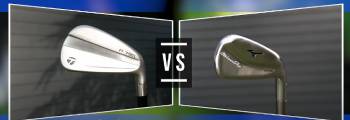
I tested both irons in dry, wet, and windy conditions.
The Mizuno Pro 245’s wrap-around sole and extra bounce excelled on firm, dry fairways.
My 7-iron held 5,200 rpm spin, stopping shots within 8 feet.
In wet rough, spin dropped to 200 yards, and mishits lost distance.
The P790’s Thru-Slot Speed Pocket shone in wet lies, maintaining 4,800 rpm spin.
Thin shots still carried 190 yards, and windy conditions favored their higher flight.
The Mizuno suits pristine courses, while the P790 handles tough conditions better.
Shaft and Grip Customization Options
Shaft and grip tweaks were key.
The Mizuno’s stock KBS Tour 120 felt stiff, so I switched to a Nippon Modus 105 for smoother feel.
I added Golf Pride MCC grips for traction, free with Mizuno.
The P790’s Dynamic Gold 105 was solid, but a Project X IO 6.0 tightened dispersion.
I chose thicker grips to match my hands.
Both offer 20+ shaft options and various grips, letting you dial in performance.
Workability for Shot Shaping
I love shaping shots, so I tested fades and draws.
The Mizuno Pro 245’s compact head and higher spin made shaping easy. I hit a 7-iron fade within 10 yards of my target.
Draws needed a closed face but held well.
The P790’s stronger lofts and lower spin reduced workability.
Fades ballooned, and draws required more effort.
The Mizuno wins for low-handicappers shaping shots, while the P790 favors straight, powerful ball flights.
Comparing to Other Players’ Irons
I compared both to my old Ping i525s.
The Mizuno Pro 245s felt softer and more precise, with better spin control.
The P790s outdistanced the i525 by 5 yards and were more forgiving.
Against Titleist T200s, the Mizuno offered superior feel, but the P790 matched distance.
The Mizuno suits players wanting forged aesthetics, while the P790 appeals to distance-seekers.
Also Read: My Thoughts On Cobra Aerojet Vs. Darkspeed
Frequently Asked Questions (FAQs)
The P790 suits 3–12 handicappers.
Some tour pros use them, but blades are more popular.
They’re best for 5–15 handicappers.
No, it’s a hollow-body players’ distance iron.
Final Thoughts
You can’t go wrong with the Mizuno Pro 245 or P790 T, and I’m stoked to guide you.
The Mizuno i525s, at $1,400, offer unmatched feel and precision, ideal for 5–15 handicappers.
The P790s, also $1,400, deliver explosive distance and forgiveness for 3–12 handicaps.
Grab yours at Golf Galaxy or PGA Superstore and elevate your game. Get fitted and swing with confidence!
